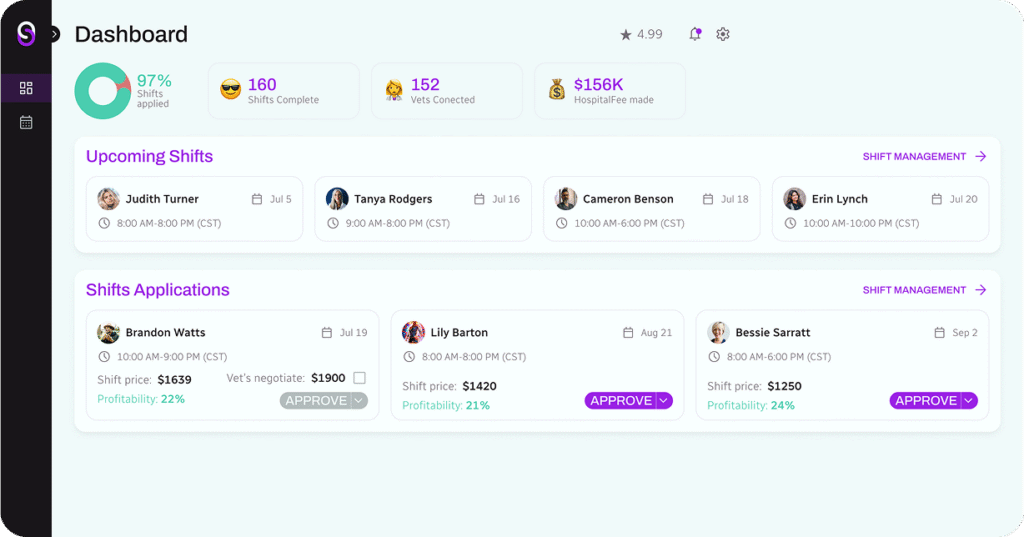
What to Look for in a Relief Vet: Skills, Experience, and Red Flags
Hiring a relief veterinarian can feel like rolling the dice. Sometimes you get a seamless fit — a doctor who walks in, wins over clients, keeps cases moving, and leaves your team grateful for the backup. Other times, you end up with the opposite: missed diagnoses, frustrated staff, and clients who quietly start calling the clinic down the street.
The difference between those two outcomes often comes down to one thing: knowing what to look for.
Relief vets aren’t just “temps.” They’re guest doctors stepping into your clinic’s ecosystem. The right relief vet can protect revenue, boost morale, and give your full-time team the breathing room they need. The wrong one can undo months of goodwill in a single shift.
This article breaks down what practice managers and owners really need to know before booking relief:
- Core skills that separate competent relief vets from costly mistakes.
- The right kind of experience (because years in practice alone tell you very little).
- Red flags that should stop you in your tracks.
- And finally, practical steps to evaluate candidates so you don’t have to gamble.
By the end, you’ll have a clear, actionable framework to make confident hiring decisions and avoid the mistakes that turn relief coverage into a liability instead of an asset.
Core Skills Every Relief Vet Should Bring

Relief vets are hired for their medical license, but kept (and rebooked) for their ability to make your practice run smoothly under pressure. When evaluating candidates, five key skill categories should be at the top of your checklist:
1. Medical Competence (non-negotiable)
A relief vet doesn’t have to be able to handle every exotic that walks through the door. But they must demonstrate competence in the bread-and-butter work that drives 80% of most clinics’ caseload: wellness exams, urgent care triage, and surgical basics like spays, neuters, and mass removals.
What separates a strong relief vet isn’t just knowing the medicine — it’s the ability to apply it consistently in a new setting, often with little orientation. Competence here means more than memorized protocols; it’s about clinical judgment, efficiency, and the confidence to make decisions even when faced with unfamiliar surroundings.
Example: A dog comes in for a routine spay, and during the pre-op exam, the relief vet detects a mild heart murmur. One doctor hesitates, unsure how to move forward in an unfamiliar clinic, and leaves the team and client waiting. Another calmly explains the finding, recommends the appropriate diagnostics, and adjusts the anesthesia plan to keep the patient safe. Both doctors knew the medicine, but only one had the confidence to apply it smoothly in a new environment.
2. Communication Skills
Medical skills keep patients alive. Communication skills keep clinics thriving. Relief vets have a double communication challenge:
- With clients: They must establish trust in minutes. A great relief vet explains care plans clearly, avoids jargon, and shows empathy without over-promising. There’s a world of difference between “This treatment plan will cost $800” and “Here’s what’s going on, here’s what it will take to fix it, and here are the options at different price points.”
- With staff: Relief vets who integrate quickly into existing workflows prevent bottlenecks. They ask questions early, listen to techs, and respect the systems already in place.
Example: The best vets don’t just say “Your dog has an ear infection.” They walk the client through what that means, what treatment will involve, and what to expect at home, in plain language. That way, the client leaves feeling informed and confident, not overwhelmed or uncertain.
3. Time & Case Management
Relief vets often face fully booked schedules and limited time to learn the ropes. Efficiency is non-negotiable, but it must be achieved without cutting corners. The strongest relief vets:
- Prioritize cases with a clear head, even in a stacked schedule.
- Recognize when to move fast and when a case needs more hands or time.
- Know when to ask for help, rather than risking mistakes.
Example: In a busy afternoon, one vet spends 40 minutes on a straightforward otitis case, throwing the schedule into chaos. Another gets the same patient diagnosed, treated, and discharged in 20 — without missing details — freeing time for the sick cat waiting in the lobby. That time management difference shows up on the revenue report and in client satisfaction scores.
4. Adaptability Across PIMS and Equipment
Relief vets don’t get a two-week onboarding. On day one, they may be documenting in a PIMS they’ve never used, working with staff who follow slightly different protocols, or using equipment set up in unfamiliar ways. The best relief vets don’t try to figure it all out alone — they ask quick questions, lean on the support team, and focus on what only a doctor can do: diagnosing, treating, and communicating with clients.
Example: One vet spends extra time trying to enter notes and build estimates on their own, slowing down appointments. Another asks a technician how the clinic prefers records to be completed and what steps the team usually handles. By trusting the staff and adapting to the established process, the second vet keeps the day running smoothly, wins staff confidence, and ensures clients aren’t left waiting.
📌 Top 5 Skills to Look For in a Relief Vet
Solid medical competence in core GP/urgent care procedures
Adaptability to different equipment, PIMS, and workflows
Clear, empathetic client communication
Respectful, collaborative teamwork with staff
Efficient case and time management under pressure.
Find Relief Vets on Your Terms
Set the rate, pick the vet, and keep your clinic running at full speed.
II. The Right Kind of Experience (It’s Not Just Years in Practice)
One of the most common hiring traps is equating “years in practice” with competence. But in relief medicine, the type of experience matters more than the number. A relief vet with three years across different settings may be far more valuable to your clinic than one who’s logged ten years in a single narrow role.
Here’s what to look for:
1. Breadth vs. Depth
A relief vet who’s rotated between general practice, emergency, and urgent care settings usually has sharper adaptability than one who’s worked in a feline-only clinic for a decade. Breadth signals exposure to diverse caseloads, workflows, and client expectations.
Example: Picture two candidates. One has 12 years in a single, low-volume suburban clinic. The other has 4 years, including GP, ER, and shelter medicine. If your clinic is a busy multi-doctor hospital, the second vet might actually be the safer bet.
2. Species and Service Mix
It’s not just about how long they’ve practiced — it’s about what they’ve practiced. Relief vets should align with your clinic’s caseload and services.
- Small animal clinics: Comfort with canine and feline wellness, dentistry, and common surgeries.
- Mixed animal practices: Relief vets must clarify their comfort zones (e.g., “I see dogs and cats, not equine”).
- Surgical scope: Not every relief vet is comfortable with dental extractions or emergency procedures. It’s better to confirm than to assume.
Example: A relief vet might shine with wellness and diagnostics, but decline dentals. If dentistry accounts for a significant portion of your revenue, that gap matters.
3. Cultural Fit Experience
Clinics aren’t just collections of patients and procedures — they’re cultures. Relief vets who’ve experienced different clinic environments adapt faster and mesh more smoothly with your team.
- Small, family-run clinics: Often require a hands-on style, with doctors pitching in across multiple roles. Relief vets who’ve worked in similar settings won’t flinch if they need to draw blood or run a quick urinalysis themselves.
- Large, multi-doctor hospitals: Demand coordination, delegation, and working within defined SOPs. Relief vets with prior large-hospital experience know how to navigate hierarchy and communicate efficiently in high-volume settings.
- Team dynamics: A vet who’s accustomed to collaborating with technicians and CSRs (rather than working in silos) is less likely to create friction.
Example: A relief vet who’s only worked in a small, close-knit two-doctor practice may struggle in a bustling ER where delegation is critical. Conversely, someone used to corporate hospitals may need to adjust to a scrappy, “everyone does a bit of everything” clinic.
III. Red Flags to Watch For
Hiring the wrong relief vet doesn’t just mean a bumpy day. It can ripple through your clinic in ways that affect revenue, morale, and client loyalty. Here are the biggest warning signs to watch for before you commit:

1. Overconfidence Without Evidence
Some vets say yes to everything. On the surface, that sounds great — flexible, capable, ready for anything. But overconfidence without proof is a liability. Relief vets who can’t articulate their limits may put patients and your practice at risk.
Example: A candidate says they’re “comfortable with all surgeries.” On day one, they freeze during a routine pyometra because they’ve never actually performed one solo. Suddenly, your staff is scrambling, the patient’s at risk, and your confidence in that doctor is gone.
2. Poor Communication or Team Fit
Medicine is a team sport. Relief vets who dismiss staff input, ignore techs, or clash with the front desk create friction that drags down the entire clinic. The problem isn’t always obvious during the interview, but it becomes apparent in morale and client experience.
Example: Your clinic has an experienced technician team that handles tasks like drawing blood, placing catheters, and running diagnostics efficiently. Instead of trusting the staff, the relief vet insists on doing those tasks themselves. The result? Delays in appointments, frustrated technicians, and a workflow that grinds to a halt. Multiply that across a full day, and morale takes a hit while clients wait longer than necessary.
3. Gaps in Professionalism
Red flags aren’t always medical — sometimes they’re administrative. Relief vets who are chronically late, vague about references, or unclear on their coverage create unnecessary risk for your practice.
- Unreliable scheduling: Last-minute cancellations leave your clinic scrambling.
- Minimal references: If no one can vouch for them, that’s a problem.
- Licensing/coverage issues: Always confirm liability coverage and active licensing before a shift is booked.
Example: One missed morning shift may not seem catastrophic. But if your clinic had 20 appointments booked, the lost revenue plus client frustration can easily hit five figures in a single day.
📌 3 Red Flags That Should Stop You in Your Tracks
1. “Yes to everything” confidence without case history or references.
2. Tension with staff or dismissive communication patterns.
3. Spotty professionalism: tardiness, weak references, or unclear coverage.
💡 Key Takeaway: Relief vets are meant to relieve pressure, not add to it. Any of these red flags should prompt a hard pause — better to lose a candidate than risk your clinic’s reputation or revenue.
IV. Practical Steps for Evaluating a Relief Vet
Skills and relief vet experience look good on paper, but how do you actually confirm that a relief vet is the right fit for your clinic? Here’s a practical framework you can apply before committing to multiple shifts.

1. Ask Smart Interview Questions
Generic questions (“What’s your experience?”) don’t reveal much. Instead, ask scenario-based questions that force a candidate to demonstrate adaptability, communication, and judgment.
Examples you can use right away:
- “Tell me about a time you adapted to a new clinic workflow in under an hour. How did you approach it?”
- “What’s your comfort zone for surgeries? Which procedures would you decline?”
- “How do you handle client pushback on treatment estimates?”
💡 Why this works: Their answers reveal not just competence, but also self-awareness and honesty about their limits.
2. Check References the Right Way
Don’t stop at “Would you hire them again?” Push for specifics that matter in day-to-day clinic life.
Better questions to ask:
- “How did they interact with your staff?”
- “What was their time management like on a busy shift?”
- “Did they ever decline a case or surgery, and how did they handle it?”
💡 Why this works: You uncover real examples of professionalism, communication, and case management — not just vague endorsements.
3. Trial Shifts & Feedback Loops
A one-shift trial can tell you more than a resume ever will. But you need structure:
- Set expectations upfront: Let the relief vet know the caseload, hours, and what success looks like.
- Assign a point person: Have a lead tech or manager observe how smoothly they integrate.
- Gather feedback: After the shift, ask your staff specific questions: Did they respect your input? Did they keep the schedule moving? Did clients leave satisfied?
💡 Why this works: A relief vet’s medicine may be solid, but your team’s morale depends on culture and communication. A trial shift reveals both.
Pro Tip: Create a simple scorecard (1–5 scale) for staff feedback on communication, adaptability, and efficiency. This keeps evaluations consistent and helps you make objective decisions.
V. How Serenity Vet Simplifies Relief Staffing

Even with a solid framework for evaluating relief vets, the process can be time-consuming. Posting shifts, comparing candidates, and negotiating rates can quickly add up to extra work for your team. That’s where Serenity Vet comes in.
Instead of leaving practices to chance, Serenity Vet gives you the tools and data to make smarter, more confident decisions:
- Set Your Own Rate
You decide what to pay, then use rate guidance and local benchmarks to make sure it’s competitive and sustainable. - Profitability Calculator
See how different pay rates affect your bottom line before you post the shift. Relief staffing becomes a strategic choice, not a financial risk. - Production Bonuses
Want to reward high performance? Build in production-based incentives that motivate top vets to pick your shift. - Negotiation & Transparency Tools
No back-and-forth emails or vague fee structures. You see exactly how much a vet will be paid, and you have clear ranges for accepting or declining proposals. - Targeted Notifications & Predictability
Your shift gets in front of qualified vets immediately. In the U.S., our AI Predictability Tool even shows you how likely the shift is to be filled, and what adjustments would improve your odds. - Pay-as-You-Go Simplicity
You only pay for completed shifts. No long-term commitments, no sunk costs.

